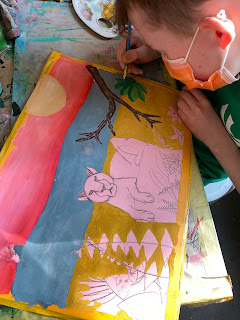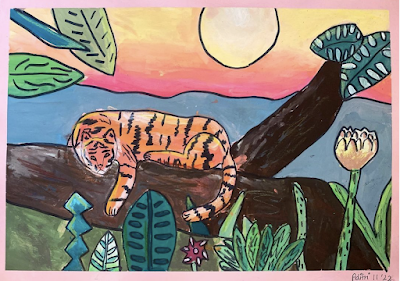 |
| Class collage - ages 9-11 |
To commemorate Chinese Lunar New Year (2022 year of the tiger), my Monday kids painted tigers on a branch with varied jungle foliage. Our objectives were plentiful for this lesson, resulting in much learning, problem-solving and superb results.
OBJECTIVES:
- Observational drawing (tiger face, tiger body in lying posture on branch)
- Draw a variety of jungle foliage and flowers from imagination and from observation
- Establish a landscape (sky, horizon line, middle ground, foreground)
- Composition - use of overlapping and variety
- Gouache painting and blending techniques
- Color mixing (with a variety of greens)
- Outlining for contrast and refinement
- Use black marker to create a stylized-look
- Use colored pencil for added texture and color variations
*A Note on Gouache:
Gouache is my favorite paining medium. Unlike acrylic, gouache is water-based and can be reactivated after dry. It's easy to use, as the texture is creamy and smooth. Because it does not dry quickly and permanently like acrylic, colors can be mixed and easily blended directly on the paper. It works superbly with mixed-media, as other media can be easily applied overtop. It's highly pigmented and intense, meaning a little goes a long way. My gouache comes in tubes, so I used to squirt paint for each student on their palette. I realized that I was throwing so much away at the end of each class. Now, I dispense gouache into small containers, and have my students simply dip their brush in the color they need, then mix it on their palette for personal use. Paint waste has been significantly reduced, as students only take what they need, as they need it. Once on their palettes, they explore with color mixing, leading to unique colors and tints. When the paint dries in the containers, I simple refresh/reactivate with a bit of water from a spritz bottle, and a spritz of rubbing alcohol to prevent molding (this can happen when not in air tight containers...).
STEP 1:
Students chose a tiger on a branch from a selection of photographs. They practiced drawing the face and posture of the tiger, using basic shapes (circles, ovals), and then refining the proportions and shapes, and adding details. I drew several tigers on the whiteboard to demonstrate this use of basic shapes.
STEP 2:
On pink paper, students established a basis landscape (skyline, horizon line, middle ground, foreground), and placed a large tree off to one side, with a branch or tree stump for the tiger to lie on. They drew their tiger on their branch, and added a variety of LARGE leaves and flowers for a FULL, interesting composition with plenty of VARIETY. These were largely drawn from imagination, with some from observation.
STEP 3:
Starting at the top and working their way down, student painted their background areas, leaving out anything in the foreground (so sky, hills, background grass, branch). Students were encouraged to mix interesting colors, blend directly on the paper, and use white to mix softer tints).
STEP 4:
Students painted all the elements in their foreground (leaves, foliage and flowers), and then the tiger. Again, color mixing and creating tints was key. Many greens, mixed with blues, yellows, browns and white creates a dynamic and varied composition.
STEP 5:
Students outlined all contours with thick black permanent marker. Tiger stripes were drawn with black marker, and smaller marker for face details. They added dots and dashes for added texture and interest.
STEP 6:
Colored pencil was used to add more depth in value, to add extra color variation, and to create more texture.
These turned out so bold and powerful - the black outlines really make all the elements pop.
 |
| Working on the foreground elements |
 |
| Paint tiger last |
FINISHED WORK
























